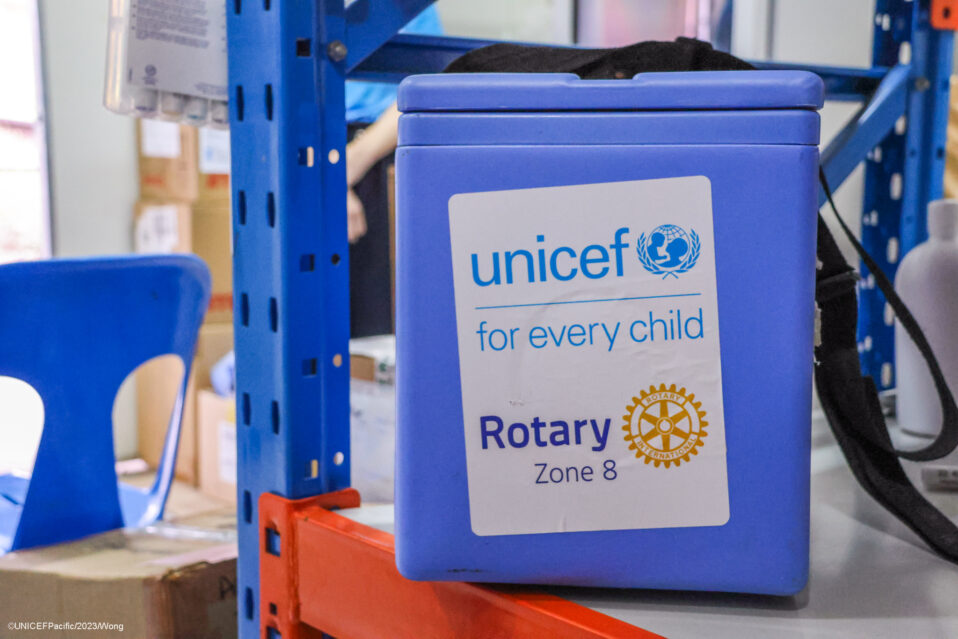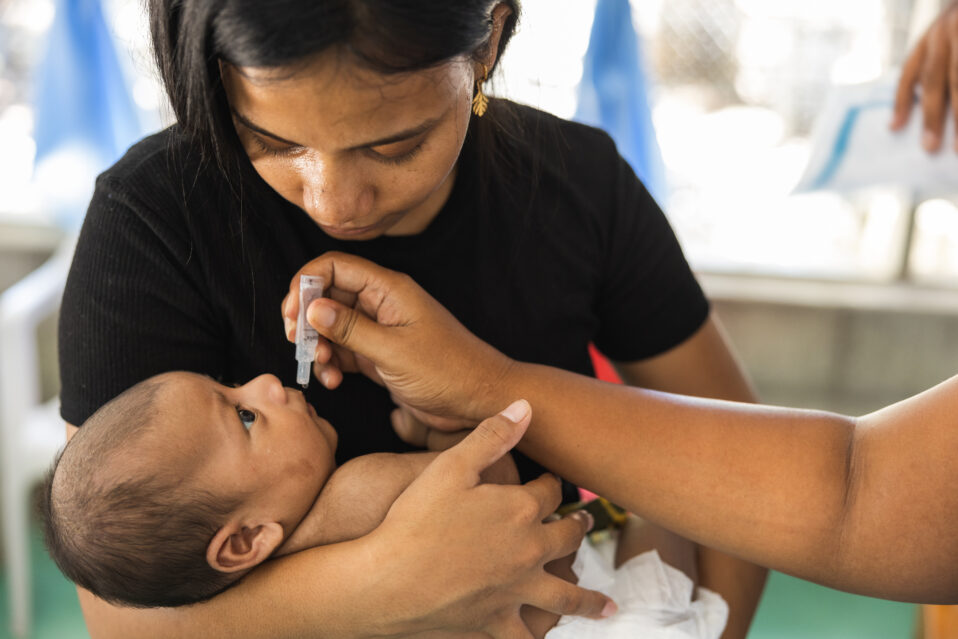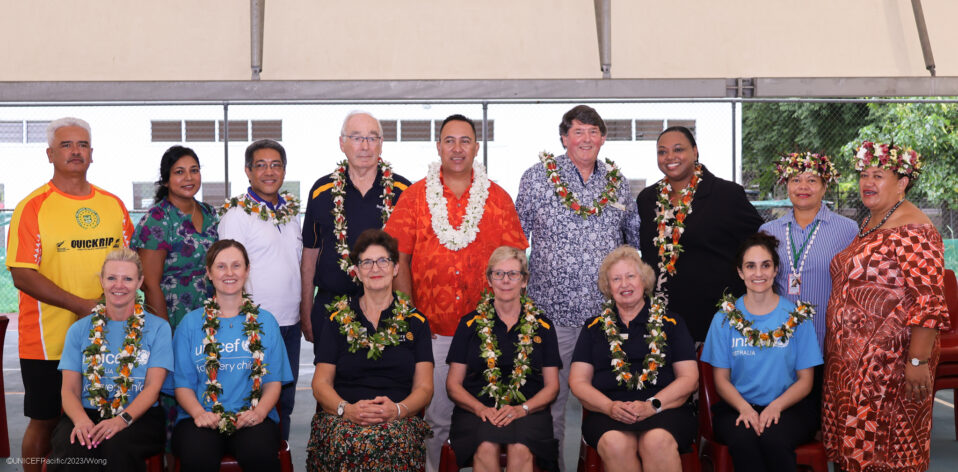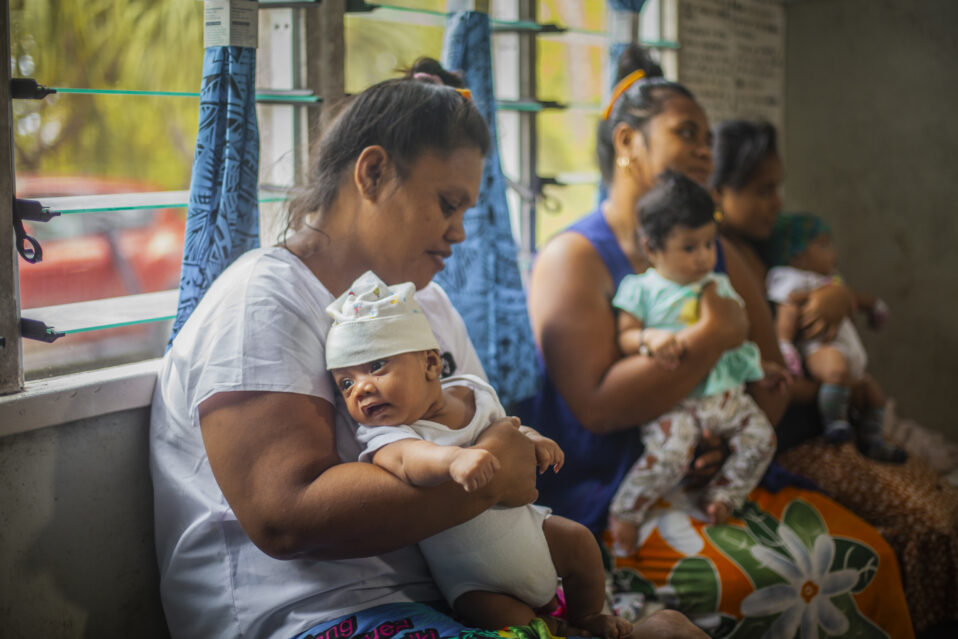Rotavirus, pneumococcal and human papillomavirus (HPV) vaccines are relatively new and consequently expensive. Although millions of doses have been given world-wide for years in many developed countries, for some governments, cost makes it difficult to prioritise their introduction into national immunisation schedules.
Rotavirus is a virus that causes diarrhoea and affects almost all children before their fifth birthday. The disease can be very severe. In developing countries parents and health providers have access to treatments which mean that children can usually avoid the potential fatal consequences of the disease. This is not true in developing countries and children continue to die unnecessarily from rotavirus diarrhoea.
HPV causes cervical cancer which affects women in the Pacific Islands at disproportionately high rates. The HPV vaccine protects against the most serious types of HPV infection. Introducing this vaccine will save women’s lives and keep families whole.
Pneumococcal vaccine reduces the risks to young children of pneumonia, meningitis, and bacteraemia.
These vaccines are life-saving and the World Health Organization recommends that all three be included in every country’s routine immunisation program.
There are needs for improved immunisation programs throughout the world. Rotary Give Every Child a Future (RGECAF) is a joint New Zealand-Australia-Pacific Islands project to celebrate Rotary Australasia’s centenary. It seemed appropriate therefore, to focus on a project that delivers in the Pacific region. We often hear that Rotarians want to support communities ‘in our own backyard’ and this project does just that.
Once it was agreed to work in the Pacific we partnered with, and took advice from, UNICEF on which countries to target. Globally, most countries are able to finance basic immunisation programs and many introduce new vaccines as they become available. Immunisation programs in the very poorest countries qualify for additional funding from organisations like GAVI. The countries selected for this project fall in between these two funding models, able to provide the basic vaccines but not able to implement additional new vaccines and not eligible for GAVI funding.
This project has been designed to reach as many children as possible over the project lifespan, with the funds we aim to raise, and will be sustained because the respective governments have made a commitment to continue the vaccine programs when the project is completed.
As part of their core business UNICEF Pacific, UNICEF New Zealand and UNICEF Australia work to protect children from vaccine-preventable diseases through immunisation programs in Pacific Island Countries. With our history of partnership, most notably in the Global Polio Eradication Initiative, it is a natural fit for Rotary and UNICEF to work together on this project. In addition:
• UNICEF is a long-term trusted partner.
• UNICEF Pacific has been operating in the region for many years. It has close relationships with governments and communities and successfully runs many immunisation programs there.
• Significant due diligence has been undertaken and we have a formal monitoring and evaluation reporting structure set up to ensure accountability.
(See ‘Rotary and UNICEF’ below for more detail)
Yes. In recent years, Rotary has put a much greater emphasis on the sustainability of its projects. Likewise, UNICEF works on the same principle always ensuring that their programs are sustainable i.e. that the end goal is they are able to be run in country, without UNICEF’s support. To facilitate this, UNICEF works in partnership with governments to design multi-year country plans, and their programs fit within these plans.
In the case of RGECAF, UNICEF will set up the program in a way that allows the governments to continue to run the immunisation programs at the end of the initial funding period. Therefore, setting up the necessary infrastructure, training healthcare workers, and working with local communities to encouraging child immunisation programs will ensure long lasting benefits. The potential savings to the national healthcare budgets through lower hospitalisation rates and lower incidence of these diseases will offset the ongoing costs of the immunisation program.
Rotarians see a problem and work to find a solution. Yes, governments and others could, and maybe should, take responsibility for these immunisation programs. However, in the case of many Pacific Island Counties, governments simply do not have the necessary resources to introduce new, and often expensive, vaccines. Like so many things in the past, Rotary needs to be the catalyst.
Establishing new vaccines into an immunisation program is expensive. In addition to the cost of purchasing the vaccines, staff have to be trained, communities and parents educated and additional vaccine storage provided. This project will establish the programs and facilitate handovers to individual governments on completion.
The Asian Development Bank is financing the introduction of these three vaccines into four of the project countries (Vanuatu, Tonga, Samoa and Tuvalu) while Rotary will fund regional and other supporting activities in those four countries and fully fund the program in the other five countries. Rotary Australasia will need to raise approximately AU$4.5-5 million to complete the project. It is difficult to be specific about the amount because of differences between the Australian, New Zealand and US dollars and fluctuating exchange rates.
RGECAF has a committee dedicated to fundraising which includes applying for Rotary Foundation global grants and seeking corporate and philanthropic sponsors. The most effective way Rotarians can participate in this project is to:
• contribute personally;
• create fundraising projects;
• seek out local corporate sponsors;
• encourage your club to donate club project funds to RGECAF;
• encourage your district to donate from their District Designated Fund.
These figures are approximations and an average to let individuals, clubs, districts and other organisations know the extent to which their donations will help. Rotary aims to raise AU$4.5 – $5 million to immunise 100,000 children over the 3-4 year duration of this project, i.e. approximately $45 per child.
This will establish the immunisation programs in each of the nine countries and provide the foundation to protect children and families for generations to come. Every dollar collected goes to the program. Whether you think in New Zealand or Australian dollars, your contribution will make a tangible difference.
GAVI is a global vaccine alliance that is funded by the Bill and Melinda Gates Foundation, in addition to other philanthropists. Based on their Gross National Income per capita (GNI), some countries qualify for GAVI support which can provide them with highly subsidised vaccines. In the Asia-Pacific both Papua New Guinea and the Solomon Islands qualify for GAVI support. However, all the countries in the Rotary Give Every Child A Future project currently have a GNI too high to qualify for GAVI funding.
UNICEF has close relationships with the relevant governments in this project. These relationships are managed formally and discussions often cover the range of projects that governments and UNICEF are working on. While we understand informal discussions between Rotarians and government contacts are likely to take place (thank you for advocating for the partnership!), the formal project discussions need to remain within the current meeting structures in place between UNICEF Pacific and the relevant governments.
The short answer is no, or at least certainly not in the short to medium term. In this era of international travel, the eradication of global diseases like HPV, rotavirus and pneumococcal disease would only be possible through the World Health Organization with specific global eradication programs. The aim of this project is to provide individuals with protection so their body’s immune system can easily deal with the bug and stop them getting sick. In addition, by vaccinating whole communities the diseases are less able to spread which protects people who have not, or cannot, be immunised.
We need to be clear that this is not a project where we mobilise groups of people from Australia, New Zealand or elsewhere to go into the Pacific to vaccinate children. Unlike polio, where the vaccine is administered by mouth, two of these vaccines are injected so can only be administered by trained healthcare workers.
For this project to be sustainable it is critical that the implementation be left in the hands of local people, increasing the capabilities of these countries to look after themselves. However, there may be opportunities for some Rotarians to visit and see first-hand what is happening and possibly participate with local clubs in community awareness raising. The people required for this may need to have particular skills/qualifications.
For the majority of Rotarians, the best way that they can help is by playing a part in raising the necessary money to fund the project, raise awareness of the issues, and by using the project to promote Rotary and the work we do. Remember, this project is a celebration of 100 years of Rotary Australasia’s service in communities around the world.
And, please follow our progress on social media, through Rotary Down Under, Rotary Voices and other Rotary websites.
Developing immunisation workforce capacity is a well-documented factor that can contribute to improvements in immunisation services delivery. Using external healthcare workers to administer vaccines does little to improve the knowledge, skills, confidence, and therefore capacity, of local service providers.
Improving workforce capacity across immunisation service providers in the project countries is one of the aims of the Rotary Give Every Child A Future and an important factor in assuring it’s sustainability.
The RGECAF project is being delivered by UNICEF and vaccines are administered by in-country healthcare workers. Healthcare professionals interested in volunteering or working for UNICEF in the Pacific, or indeed other regions of the world, can apply to UNICEF. As part of the United Nations, UNICEF recruits volunteers through UN Volunteers and employment opportunities can be found on the UNICEF Vacancies page.
As in the answer to the previous question, there will be some opportunity to visit the Pacific to observe the project. Details when available will be advertised through our website, social media and Rotary Downunder articles.
Along with all Rotarians, we hope you will support this Centenary project.
UNICEF is a signatory to the international transparency trade initiative. In 2016, the Aid Transparency Index placed UNICEF in the ‘very good’ category, rated third out of 46 organisations. In 2015, UNICEF launched a transparency microsite showing exactly where and when funds raised are spent.
UNICEF Australia and UNICEF New Zealand will produce annual project reports showing where the funds raised have been spent and the difference this is making. There will also be opportunities for Rotary representatives to go to the Pacific to see the project first hand, enabling them to report back to fellow Rotarians.
UNICEF is the largest single purchaser of vaccines in the world. While the final prices for vaccines for this project have yet to be confirmed, the expectation is that UNICEF will be able to negotiate the best possible price for the most appropriate vaccines.
UNICEF applies the principles of value for money to all its programs i.e. economy, efficiency, equity and effectiveness. No one element of value for money is more important than the other. For example, the benefit of cheap vaccine prices may be outweighed by reduced effectiveness based on the implementation context.
It is also worth emphasising that the procurement of vaccines is only part of the cost of delivering a program such as this. The Pacific has, literally hundreds and hundreds of islands dispersed over 16% of the earth’s surface. That’s an incredibly difficult logistical challenge. It means planes, boats and automobiles, people on donkeys, people carry things on their backs. UNICEF is working hard to reach every community.
Yes! There is a long history of the two organisations working together and very successfully so. Most notably the Global Polio Eradication Initiative where Rotary along with UNICEF and other partners have reduced polio cases by 99.9% since our first child vaccinate project in the Philippines in 1999. There are many, less well-known projects around the world where Rotary and UNICEF have worked together. UNICEF has been an implementing organisation on many Rotary Foundation Global Grant projects. There is therefore a high level of trust and respect between the two organisations.
The answer varies for the three vaccines:
For the rotavirus vaccine recipients may have slightly increased risk of developing mild diarrhoea or vomiting in the week after being vaccinated. Serious side effects are very rare but there is a slightly increased risk of intussusception, a rare form of bowel blockage. However, the risks of rotavirus gastroenteritis are many times greater than the very small risk of the vaccine. Before rotavirus vaccine became available in Australia and New Zealand, almost every child was infected by rotavirus by the age of 5 years. In Australia, about 10,000 young children were hospitalised with rotavirus gastroenteritis each year and up to one young child a year died from complications. Since rotavirus vaccinations started there in 2007, more than 7,000 hospital admissions for rotavirus have been prevented each year. Those who do go to see a doctor are less sick. This compares with more than 200 babies being hospitalised for intussusception each year, of which only about an extra 14 may be related to having received rotavirus vaccine. Based on the established benefits of rotavirus vaccine and the rare occurrence of intussusception, the World Health Organization and the New Zealand and Australian Immunisation Advisory Committees recommend the continued use of rotavirus vaccine for infants on immunisation programs.
The pneumococcal vaccine is very safe, although, like all vaccines, there are possible side effects. It is not possible to catch a pneumococcal infection from the vaccine, as the vaccine doesn’t contain any live bacteria. Mild side effects of the pneumococcal conjugate vaccine (PCV), which is the version of the pneumococcal vaccine given to babies under the age of two, include: decreased appetite, a slightly raised temperature, irritability, redness, hardness or swelling at the site of the injection, feeling sleepy or not sleeping well. More serious side effects are very rare, but include a high temperature, possibly leading to convulsions (febrile seizures) and allergic/anaphylactic reactions.
With HPV vaccine, some people might experience mild adverse effects typical of other injected vaccines: soreness, swelling, redness at the injection site, mild temperature or feeling faint. The World Health Organization’s Global Advisory Committee on Vaccine Safety continues to review the accumulating data on HPV vaccine safety and finds that the vaccine is safe, with over 10 years of data and over 200 million doses given worldwide.
The first point that can be made is that the HPV vaccine is not a contraceptive. It is providing young women with protection against various cancers for decades to come, particularly the most common forms of cervical cancer. It is true that they are not able to become infected with HPV unless they become sexually active. However, it is also true that the vaccine is much more effective if given before the person becomes infected and before their mid-teens. So, the target group is the 12-15 year old girls but this should not be seen as in any way encouraging them to become sexually active, indeed quite the opposite. In addition, delaying the vaccine puts the young person at risk as they are dependent on someone remembering to administer the vaccine later and before they have any sexual relations. Of course, these conversations have to be handled appropriately in each country in the context of the social attitudes of that society. To help address this issue, this project includes social mobilisation activities before the introduction of HPV vaccine in each country. These activities help communities, local leaders and religious groups to gain a healthy understanding of the HPV vaccine and what immunisation means.
It is essentially a question of available resources and setting priorities. The recommendation from WHO and others is that we should give priority to the girls. Vaccinating the boys will give them protection against some relatively rare cancers and, perhaps more importantly, it can also restrict transmission of the virus. However, the HPV vaccine is the most expensive of the three vaccines that we will be distributing and therefore it would add substantially to the cost of the project to extend the program to include the boys. There is also a question of sustainability as not all counties may be able to afford the continuing cost if the boys were included. Of course, it would be great to be able to vaccinate the boys as well, but the girls are the priority.






